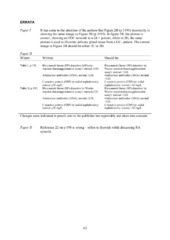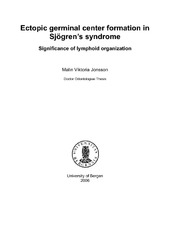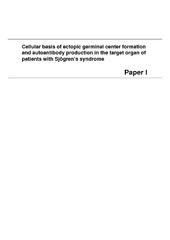| dc.contributor.author | Jonsson, Malin Viktoria | en_US |
| dc.date.accessioned | 2006-06-15T10:43:50Z | |
| dc.date.available | 2006-06-15T10:43:50Z | |
| dc.date.issued | 2006-06-23 | eng |
| dc.identifier.isbn | 82-308-0176-2 | en_US |
| dc.identifier.uri | https://hdl.handle.net/1956/1293 | |
| dc.description | This thesis is based on the following papers, which will be referred to in the text by their Roman numerals: I. Salomonsson S, Jonsson MV, Skarstein K, Hjälmström P, Wahren-Herlenius M, Jonsson R. Cellular basis of ectopic germinal center formation and autoantibody production in the target organ of patients with Sjögren’s syndrome. Arthritis & Rheumatism 2003;48(11):3187-201. II. Jonsson MV, Szodoray P, Jellestad S, Jonsson R, Skarstein K. Association between circulating levels of the novel TNF family members APRIL and BAFF and lymphoid organization in primary Sjögren’s syndrome. Journal of Clinical Immunology, 2005;25(3):189-201. III. Jonsson MV, Skarstein K, Jonsson R, Brun JG. Germinal centers in primary Sjögren’s syndrome indicate a certain clinical immunological phenotype. Submitted. IV. Jonsson MV, Salomonsson S, Gunnvor Øijordsbakken, Skarstein K. Elevated serum levels of soluble E-cadherin in patients with primary Sjögren’s syndrome. Scandinavian Journal of Immunology, 2005;62(6):552-9. V. Jonsson MV, Delaleu N, Brokstad KA, Berggreen E, Skarstein K. Impaired salivary gland function in NOD mice – association with changes in cytokine profile but not with salivary gland histopathology. Arthritis & Rheumatism, in press. | en |
| dc.description.abstract | Sjögren’s syndrom (SS) is an autoimmune, chronic inflammatory disorder predominantly affecting the salivary and lacrimal glands. The overall aim of this study was to determine clinicopathological features in human and murine disease with regard to organization of ectopic lymphoid tissue, and to explore possible strategies for detection of patients at increased risk for extra-glandular manifestations. Mononuclear cell infiltrates in the shape of germinal centers (GC) were observed in the salivary glands of approximately 1/4th of patients. Phenotypic markers for GC components such as T and B cells, proliferating cells, follicular dendritic cells and plasma cells confirmed the ectopic GC formation. The pattern and distribution of homing and retentive chemokines CXCL12, CXCL13 and CCL21, and adhesion molecules/integrin pairs ICAM/LFA and VCAM/VLA, was described in various lymphoid organizations in minor salivary glands. In addition, local autoantibody production was detected and correlated with serum levels. Focal infiltrates and GC could be observed within the same gland, and were separated by altered B and T cell ratios, higher degree of proliferation and the localization of plasma cells in the periphery of infiltrates. Serum levels of BAFF and APRIL were elevated in pSS, and were in part linked to focus score, elevated serum IgG and autoantibody levels. In a large cohort of pSS, ectopic GC were also associated with higher focus scores, lower mean un-stimulated salivary secretion, Ro/SSA and La/SSB autoantibodies, elevated RF-titres and increased serum IgG. Not all morphological GC could be confirmed by CD21/CD23/CD35 labeling, but clinical features remained comparable. E-cadherin, an adhesion molecule important for epithelial tissue integrity, was investigated in minor salivary glands. E-cadherin is the ligand of integrin αEβ7/CD103 and lymphocytes expressing this integrin were increased in SS compared to non-SS. E-cadherin+ infiltrating cells were identified as CD68+ macrophages. Serum levels of sE-cadherin were increased in pSS compared to healthy blood donors and most likely mirror the chronic inflammatory state. The non-obese diabetic (NOD) mouse is an animal model of SS. We observed significant changes in inflammation between 8 and 17 weeks of age, while hyposalivation was first observed between 17 and 24 weeks. In 1/3rd of mice older than 17 weeks, proliferating cells were observed in the focal infiltrates. Significant differences were detected in serum cytokine levels of IL-2, IL-5 and GM-CSF, and IL-4 and TNF-α in saliva. Salivary secretion correlated with IL-4, IFN-γ and TNF-α levels in saliva of NOD mice, but not with inflammatory changes in the salivary glands. Focal sialadenitis preceded hyposalivation, which occurred without a significant change in inflammation in NOD mice. Proliferating inflammatory cells indicate contribution of local factors in progression of SS-like disease. In conclusion, ectopic germinal centers occur in a sub-group of patients with SS and are characterized by autoantibody production, progressive disease and increased serum IgG. It remains unclear whether the observed GC are a result of long-standing inflammation or indeed have functional properties and thus play an active role in the pathogenesis. A future challenge will be to identify and target trafficking molecules which drive the chronic inflammation in SS, without affecting migration and function of leukocytes required for protective immunity. | en_US |
| dc.format.extent | 1431172 bytes | eng |
| dc.format.mimetype | application/pdf | eng |
| dc.language.iso | eng | eng |
| dc.publisher | The University of Bergen | eng |
| dc.title | Ectopic germinal center formation in Sjögren’s syndrome: Significance of lymphoid organization | en_US |
| dc.type | Doctoral thesis | |
| dc.subject.nsi | VDP::Medisinske Fag: 700::Klinisk odontologiske fag: 830 | nob |


